U bent hier
Openbaarheid
Beautifully-Preserved Frescoes with Figures from the Trojan War Discovered in a Lavish Pompeii Home

Image via Pompeii Archaeological Park
Imagine visiting the home of a prominent, wealthy figure, and at the evening’s end finding yourself in a room dedicated to late-night entertaining, painted entirely black except for a few scenes from antiquity. Perhaps this wouldn’t sound entirely implausible in, say, twenty-first century Silicon Valley. But such places also existed in antiquity itself: or at least one of them did, as recently discovered in Pompeii. Preserved for nearly two millennia now by the ash of Mount Vesuvius, the ruins of that city give us the clearest and most detailed archaeological insights we have into life at the height of the Roman Empire — but even today, a third of the site has yet to be excavated.
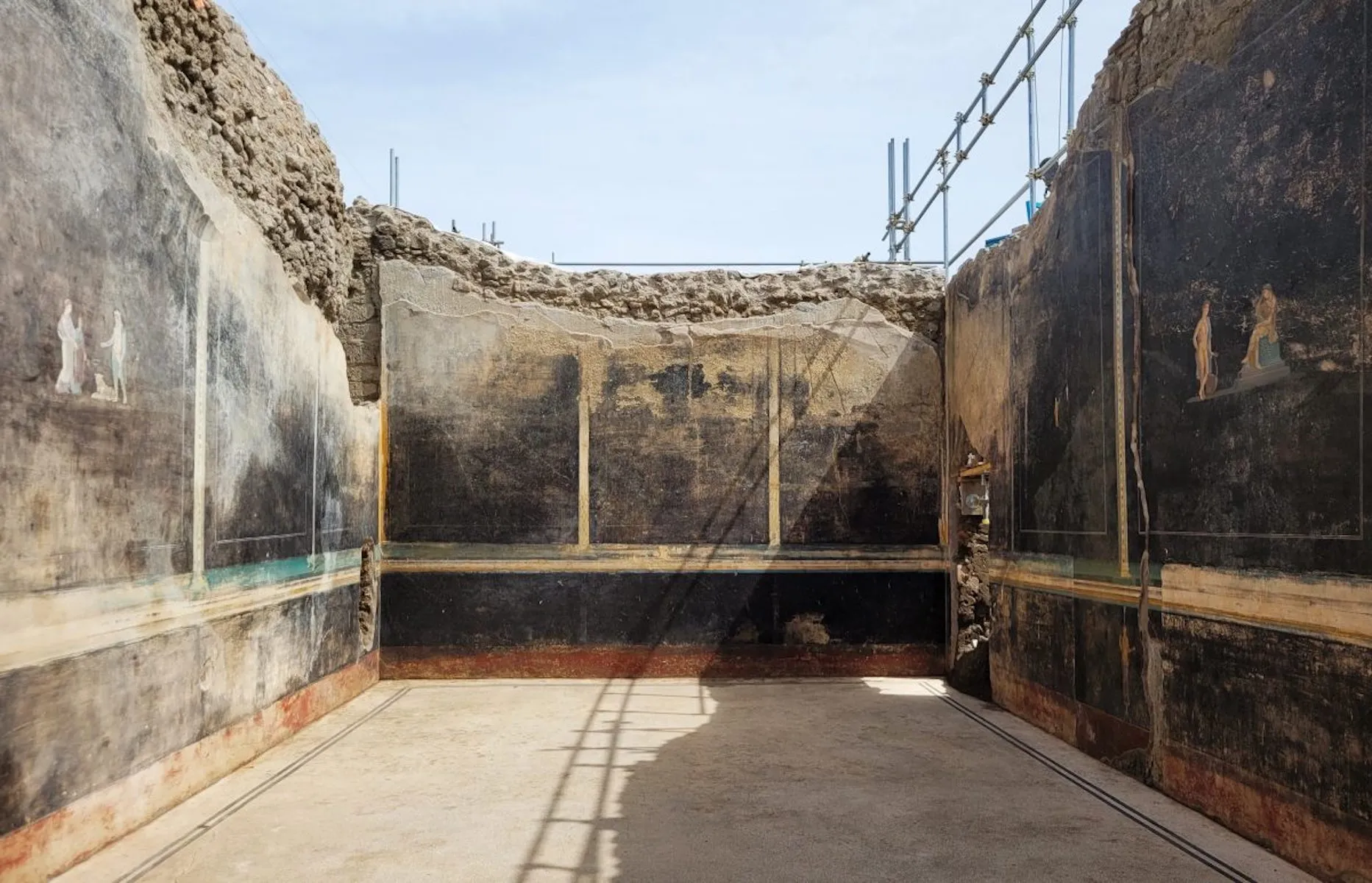
That archaeological dig continues apace, and its latest discovery — more recent than the Pompeiian “snack bar” and “pizza” previously featured here on Open Culture — is “a spectacular banqueting room with elegant black walls, decorated with mythological characters and subjects inspired by the Trojan War,” including such mythological characters as Helen, Paris, Cassandra, and Apollo.
(adsbygoogle = window.adsbygoogle || []).push({}); . -->“It provided a refined setting for entertainment during convivial moments, whether banquets or conversations, with the clear aim of pursuing an elegant lifestyle, reflected by the size of the space, the presence of frescoes and mosaics dating to the Third Style.”
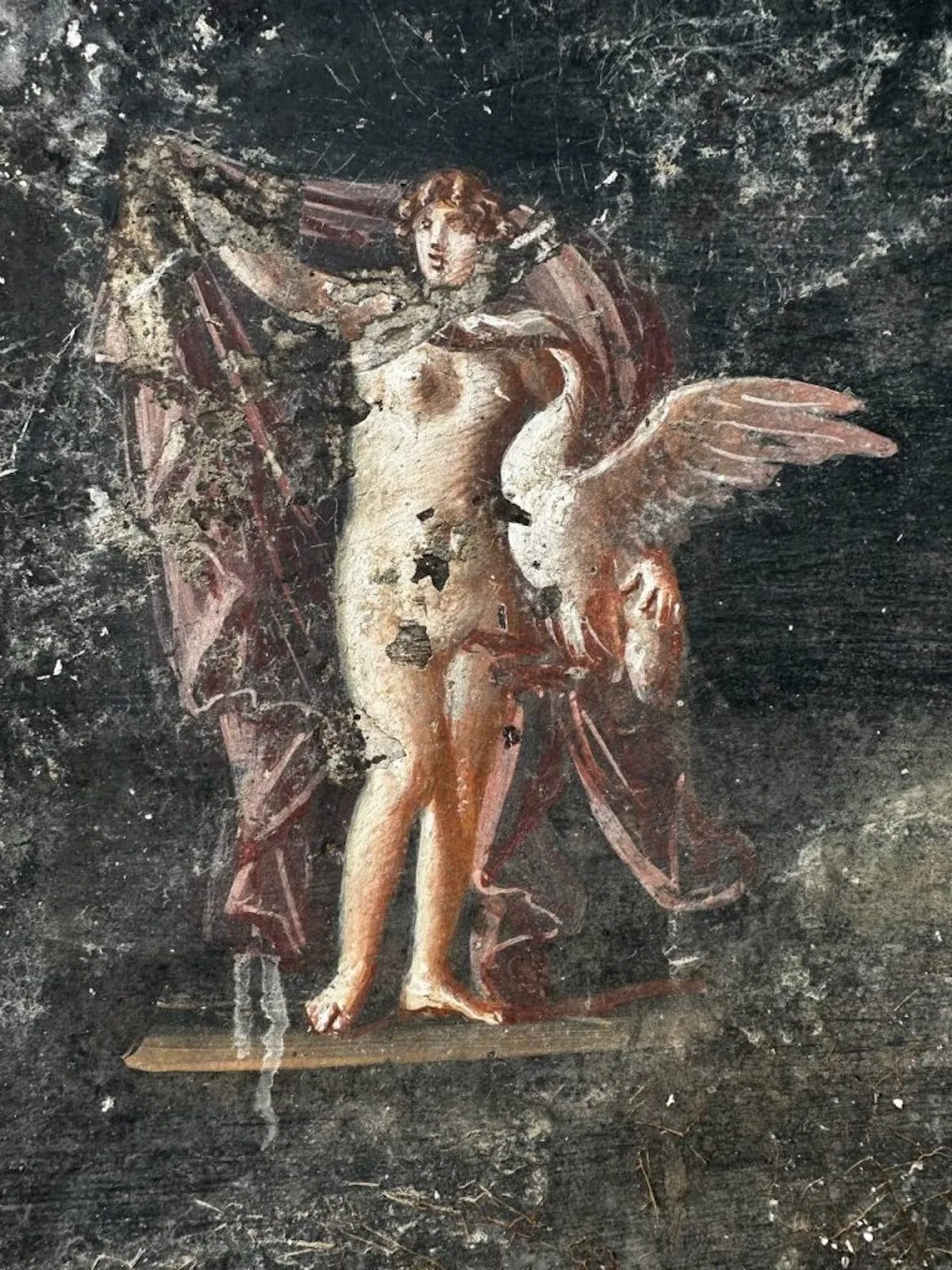
Frescoes in that Roman Third Style, explains Hyperallergic’s Rhea Nayyar, feature “small, finely painted figures and subjects that seem to float within monochromatic fields,” designed “to mimic framed works of art or altars through illusions resembling carved beams, shaded pillars, and shining candelabras — all of which were painted on flat walls.”
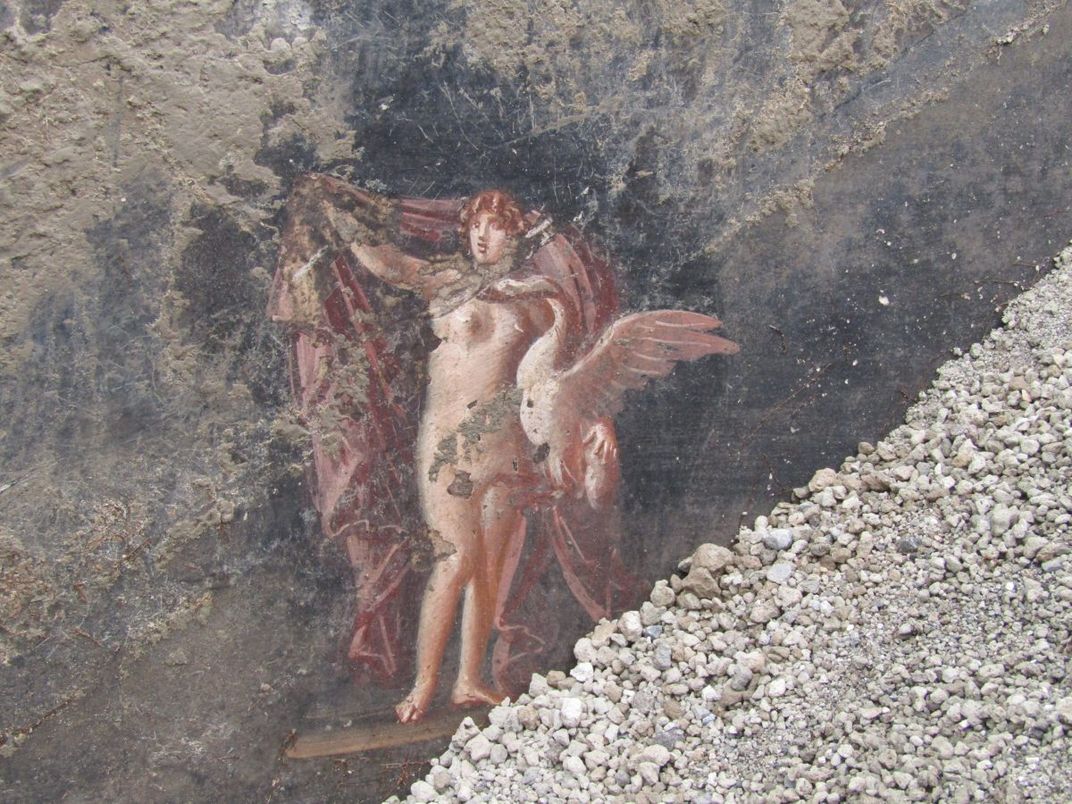
The color of those walls, in this case, seems to have been chosen to hide the carbon deposits left by oil lamps burning all night long. As reported by BBC Science News, the commissioner of this room, and indeed of the lavish house in which it’s located, may have been Aulus Rustius Verus, a “super-rich” local politician who — assuming decisive archaeological evidence emerges in his favor — also knew how to party.

via Hyperallergic
Related content:
A Newly-Discovered Fresco in Pompeii Reveals a Precursor to Pizza
Take a High Def, Guided Tour of Pompeii
Archaeologists Discover an Ancient Roman Snack Bar in the Ruins of Pompeii
Watch the Destruction of Pompeii by Mount Vesuvius, Re-Created with Computer Animation (79 AD)
Pompeii Rebuilt: A Tour of the Ancient City Before It Was Entombed by Mount Vesuvius
Based in Seoul, Colin Marshall writes and broadcasts on cities, language, and culture. His projects include the Substack newsletter Books on Cities, the book The Stateless City: a Walk through 21st-Century Los Angeles and the video series The City in Cinema. Follow him on Twitter at @colinmarshall or on Facebook.
Creating Your Own Custom AI Assistants Using OpenAI GPTs: A Free Course from Vanderbilt University
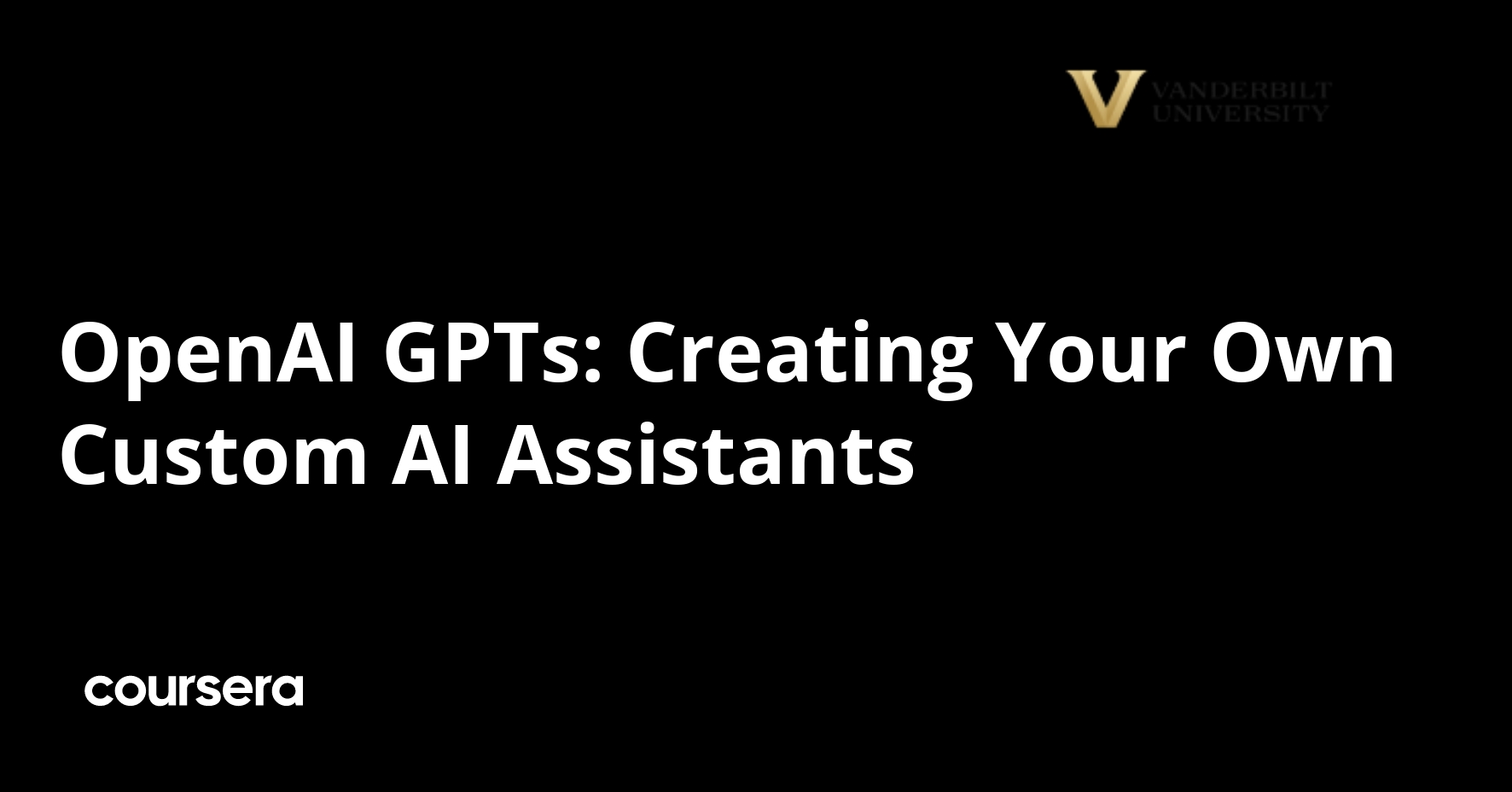
Last fall, OpenAI started letting users create custom versions of ChatGPT–ones that would let people create AI assistants to complete tasks in their personal or professional lives. In the months that followed, some users created AI apps that could generate recipes and meals. Others developed GPTs to create logos for their businesses. You get the picture.
If you’re interested in developing your own AI assistant, Vanderbilt computer science professor Jules White has released a free online course called “OpenAI GPTs: Creating Your Own Custom AI Assistants.” On average, the course should take seven hours to complete.
Here’s how he frames the course:
This cutting-edge course will guide you through the exciting journey of creating and deploying custom GPTs that cater to diverse industries and applications. Imagine having a virtual assistant that can tackle complex legal document analysis, streamline supply chain logistics, or even assist in scientific research and hypothesis generation. The possibilities are endless! Throughout the course, you’ll delve into the intricacies of building GPTs that can use your documents to answer questions, patterns to create amazing human and AI interaction, and methods for customizing the tone of your GPTs. You’ll learn how to design and implement rigorous testing scenarios to ensure your AI assistant’s accuracy, reliability, and human-like communication abilities. Prepare to be amazed as you explore real-world examples and case studies, such as:
1. GPT for Personalized Learning and Education: Craft a virtual tutor that adapts its teaching approach based on each student’s learning style, providing personalized lesson plans, interactive exercises, and real-time feedback, transforming the educational landscape.
2. Culinary GPT: Your Personal Recipe Vault and Meal Planning Maestro. Step into a world where your culinary creations come to life with the help of an AI assistant that knows your recipes like the back of its hand. The Culinary GPT is a custom-built language model designed to revolutionize your kitchen experience, serving as a personal recipe vault and meal planning and shopping maestro.
3. GPT for Travel and Business Expense Management: A GPT that can assist with all aspects of travel planning and business expense management. It could help users book flights, hotels, and transportation while adhering to company policies and budgets. Additionally, it could streamline expense reporting and reimbursement processes, ensuring compliance and accuracy.
4. GPT for Marketing and Advertising Campaign Management: Leverage the power of custom GPTs to analyze consumer data, market trends, and campaign performance, generating targeted marketing strategies, personalized messaging, and optimizing ad placement for maximum engagement and return on investment.
You can sign up for the course at no cost here. Or, alternatively, you can elect to pay $49 and receive a certificate at the end.
As a side note, Jules White (the professor) also designed another course previously featured here on OC. It focuses on prompt engineering for ChatPGPT.
Related Content
A New Course Teaches You How to Tap the Powers of ChatGPT and Put It to Work for You
‘Nederlanders mogen gokschulden terugvorderen’
De rechtbank Overijssel heeft besloten dat Unibet een Nederlander zijn gokschulden van ongeveer 8.600 euro moet terugbetalen. Dat meldde Emerce vorige week. Het vonnis zelf is niet direct te vinden: er is alleen een persbericht van de advocaat van de gelukkige gokker. Het lijkt dus een tikje prematuur om te stellen dat iedereen nu zijn geld terug kan krijgen van een illegale goksite, maar er zit meer achter.
De betrokken advocaat doet dit vaker, en met succes. Alle zaken komen min of meer op hetzelfde neer: een Nederlandse consument ging een kansspelovereenkomst aan met een partij die in Nederland geen vergunning heeft. Naar Nederlands recht is zo’n overeenkomst dan nietig/vernietigbaar (strijd met openbare orde, 3:40 BW). Het geld is dan betaald zonder rechtsgrond en moet dan terug.
In al die zaken (lees deze of deze als voorbeeld) zie je dat rechters zich actief sterk maken voor de consument. Het is altijd duidelijk zat dat die sites zich (ook) richten op Nederland, de forumkeuzebedingen gaan linea recta de prullenbank in en ik zie zelfs “litigation bullying” als verwijst naar de goksites als die al te veel processtappen nemen.
De meeste vonnissen zijn tussenvonnissen om punten zoals bevoegdheid of gebondenheid aan Nederland uit te maken. Er zijn ook een paar uitspraken die wel eindvonnis zijn, zoals deze met als terug te betalen bedrag € 128.415,76, dus de nettoschuld die de consument nog had als je zijn winsten van de inleg afhaalt. In deze zaak ging het om € 93.210,71 en dat zijn forse bedragen.
En ja, dit is te verhalen: het casino zit op Curaçao, dat is gewoon deel van hetzelfde Koninkrijk als Nederland. Ook bij een casino in zeg Malta (waar er veel online gevestigd zijn) is dat mogelijk, vanwege Europese regels over tenuitvoerlegging. De enige vraag is of de deurwaarder een bankrekening kunt vinden waar het geld op staat.
Arnoud
Het bericht ‘Nederlanders mogen gokschulden terugvorderen’ verscheen eerst op Ius Mentis.
SCCR/45: COMMUNIA Statement on Limitations and Exceptions
In our capacity as accredited observers of the WIPO Standing Committee on Copyright and Related Rights (SCCR), we are attending the 45th session of the Committee, which is currently taking place in Geneva (April 15-19, 2024).
We made the following statement regarding limitations and exceptions for educational and research institutions and for persons with other disabilities (Agenda Item 6):
Dear Delegates,
Many of us here today will remind you that knowledge institutions face many challenges when it comes to fulfilling their public interest missions in the digital environment. These hurdles range from lack of harmonisation of copyright exceptions to legal uncertainty and fear of litigation.
In the words of Marcin, a researcher from Poland researching ancient Chinese literature and contemporary culture, and I quote “a considerable part of the work is thinking about what I can do and what I can’t do, what is legal, what is illegal”.
These obstacles are particularly problematic in a cross-border environment, where a fragmented legal framework negatively affects these activities, forcing for instance researchers to limit or abandon collaborative projects, or to select research partners according to their national copyright laws. The 2nd edition of our publication “Nobody puts research in a cage”, where we interview researchers engaged in joint and cross-border projects, shows this very clearly.
If you want case studies to understand what are the kinds of problems that you should be fixing right now, this is a good start. From researchers stuck in cages in Sweden, to researchers flying across continents to be able to research Chinese movies from the TVs of their hotel rooms, it’s unsettling to read about the obstacles they face to conduct their research projects. But it’s also fascinating to see the solutions that they propose to tackle these problems.
Sure enough, they all want more copyright exceptions, more legislation granting them rights to use copyrighted works, particularly in an international environment. And this Committee knows that there are various binding and non-binding ways of getting close to that place. With all due respect, toolkits published on an obscure corner of the WIPO website, where there are about 6000 entries for the word “toolkits”, are just not it.
We understand why this would be a priority for the Secretariat, but if this Committee is truly committed to implement their work program on L&Es, the way forward are the working groups foreseen there. And again, with all due respect, we are appalled to see that, one year after the approval of the work program, you have not been able to agree on the scope and modalities of such working groups. We thus urge you to not leave this meeting without an implementation agreement in place.
The post SCCR/45: COMMUNIA Statement on Limitations and Exceptions appeared first on COMMUNIA Association.
SCCR/45: COMMUNIA Statement on Broadcasting Organizations
In our capacity as accredited observers of the WIPO Standing Committee on Copyright and Related Rights (SCCR), we are attending the 45th session of the Committee, which is currently taking place in Geneva (April 15-19, 2024).
We made the following statement regarding the protection of Broadcasting Organizations (Agenda Item 4):
Dear Delegates,
The proposed broadcast treaty, in its current version, remains a threat to the Public Domain and usage rights, particularly when legal protection of broadcasters is shaped in the form of exclusive rights, on top of rights that apply to content.
The rights-based model suggests that broadcasters will benefit from secondary rights for exploitation and control following fixation of the broadcast signal, without sufficient consideration for the public interest needs related to access to knowledge and information of signal content. In the current text, none of the exceptions are mandatory and there is no Public Domain safeguard.
Broadcasters own extensive collections of exclusive content that is highly valuable for researchers, educators, learners, cultural heritage institutions, and the general public. These collections document not only popular culture and the entertainment industry, but also function as historical documents, educational resources and research sources.
Often, the only way of accessing high-quality copies of the content in those collections is through broadcasting. Therefore, it is essential to limit exclusive rights with adequate usage rights, and ensure that, when the signal content is in the Public Domain, broadcasters are prevented from claiming exclusive rights and taking that content out of the Public Domain.
Countries opting for a rights-based model should be required to implement at least those exceptions that are already mandatory for copyrighted works (quotation, news of the day, and providing access for the visually impaired). Furthermore, they shall be required to provide in their domestic laws that, when the term of protection of the signal content has expired, the rights and protection guaranteed in this Treaty shall not apply.
The post SCCR/45: COMMUNIA Statement on Broadcasting Organizations appeared first on COMMUNIA Association.
An Archive of Vividly Illustrated Japanese Schoolbooks, from the 1800s to World War II

If you want to appreciate Japanese books, it helps to be able to read Japanese books. It helps, but it’s not 100 percent necessary: even if you’ve never learned a single kanji character, you’ve probably marveled at one time or another at the aesthetics of Japan’s print culture. Maybe you’ve even done so here at Open Culture, where we’ve previously featured archives of Japanese books going back to the seventeenth century, a collection of Japanese wave and ripple designs from 1980, a Japanese edition of Aesop’s Fables from 1925, and even a fantastical history of America from 1861 — all of which display a heightened design sensibility not as easily found in other lands.

The same even holds true for Japanese schoolbooks and other educational materials, a digital archive of which you can explore on the web site of Japan’s National Institute for Educational Policy Research. “Ranging from brush painting guides to elementary readers to the geography of Koshi Province — now the Hokuriku region — hundreds of digital scans reveal what students were learning in school more than 100 years ago,” writes Colossal’s Kate Mothes.
(adsbygoogle = window.adsbygoogle || []).push({}); . -->Certain publications, like the epistolary 冨士野往来 (“Mount Fuji Comings and Goings”) from 1674, date back much further. But only a couple of centuries later did Japanese books start integrating the colorful artwork that still looks so vivid to us today. You’ll find particularly rich examples of such books in the sections of the archive dedicated to educational pictures, wall charts, and sugoroku, a kind of traditional board game.

Originally produced, for the most part, in the mid-to-late nineteenth century (though with some items as recent as the time of World War II), these provide a look at the worldview that Japan presented to its young students during a period when, not long emerged from more than 200 years of deliberate isolation, the country was taking in foreign influence — and especially Western influence — at a breakneck pace.

But despite a variety of proposed dramatic language reforms (which would later include the wholesale adoption of English), Japan would continue almost exclusively to speak and read Japanese. If you’re interested in learning it yourself, the reading materials in this archive will surely work as well for you as they did for the students of the eighteen-nineties. And even if you’re not, they’re still timeless object lessons in educational illustration and design. Enter the collection here.

via Colossal/Present & Correct
Related content:
Download Classic Japanese Wave and Ripple Designs: A Go-to Guide for Japanese Artists from 1903
Based in Seoul, Colin Marshall writes and broadcasts on cities, language, and culture. His projects include the Substack newsletter Books on Cities, the book The Stateless City: a Walk through 21st-Century Los Angeles and the video series The City in Cinema. Follow him on Twitter at @colinmarshall or on Facebook.
Free: Download the The Anarchist’s Tool Chest, The Anarchist’s Design Book, The Anarchist’s Workbench & Other Woodworking Texts

For Christopher Schwarz, American anarchism isn’t “about bombs and leather jackets; it’s about being an independent designer.” It’s about working outside “massive and dehumanizing institutions” (like corporations) and designing beautiful objects that last. He writes: “As a designer of books, tools and furniture, I have zero desire to make things that are intended from the get-go to fall apart.” Based in Covington, Kentucky, Schwarz runs a small woodworking business where he handcrafts beautiful tables, chairs and other pieces of furniture. He also runs Lost Art Press, which publishes books like The Anarchist’s Tool Chest, The Anarchist’s Design Book, The Anarchist’s Workbench, and other titles.
His “Anarchist” series of books “represent a 10-year effort to make woodworking more accessible, affordable and ethical – and less commercial.” Typically the print editions run $30-$54. But, to the delight of many fellow woodworkers, Schwarz has made several editions available as free digital downloads. This includes (as of this week) The Anarchist’s Tool Chest, which “shows you how you can build furniture with only a small kit of high-quality tools. The first half of the book explains in detail how to choose the right tools… The second half of the book shows you how to build a traditional tool chest to hold these tools.” To find a complete list of books available as free downloads, see the list below.
- The Anarchist’s Tool Chest
- The Anarchist’s Design Book
- The Anarchist’s Workbench
- The Art of Joinery
- Roman Workbenches
- The Stick Chair Book
The Annotated AI Act komt eraan
113 artikelen, 13 bijlagen, 180 overwegingen, verwijzingen naar 27 andere wetten: de AI Act is het meest complexe stuk wetgeving dat ik ooit heb gezien. Mijn nieuwe boek “The Annotated AI Act” verheldert en analyseert de wet in gewone taal. Je kunt nu al voorintekenen!
Op hoofdlijnen is de AI Act vast al bekend. Een risicogebaseerde regulering van AI systemen, met aparte regels voor general-purpose AI en een markeerplicht voor synthetische content. Maar de risicobenadering werkt nét even anders dan bijvoorbeeld de AVG; het gekozen model is dat van productveiligheid en conformeren aan standaarden (CE keurmerk).
Met name in de laatste maanden van 2023 is er veel gebeurd met de tekst. Er moest en zou een regulering van GPAI in komen, maar dat past niet echt bij die productveiligheidsbenadering, en de auteursrechtlobby had zich ook gemeld ondertussen. Dit leidde tot een paar marathonsessies in december, waar uiteindelijk een politiek akkoord uit kwam dat in de maanden daarna uitgewerkt werd.
(Ik ben gaan schrijven toen dat akkoord er was, en moest uiteraard alles omnummeren toen de definitieve tekst werd gedropt want toen werden artikel 29a, overweging 80z+1, het lege artikel 19 en de twee artikelen 54 en nog wat van die missers aangepast.)
De haast heeft helaas een aantal dingen laten we zeggen iets minder optimaal gestructureerd. Het is dus flink zoeken naar het juiste artikel, of de combinatie met andere artikelen. Dat is waar ik dit boek voor geschreven heb: kruisverwijzingen, contrasten en literatuur (100+ referenties) voor meer achtergrond of kritische beschouwing.
Het boek verschijnt in mei wanneer de AI Act gepubliceerd is. Maar je kunt nu al voorintekenen:
Bestel The Annotated AI Act nu!
Arnoud
Het bericht The Annotated AI Act komt eraan verscheen eerst op Ius Mentis.
How the Berlin Wall Worked: The Engineering & Structural Design of the Wall That Formidably Divided East & West
More than thirty years after the formal dissolution of the Union of Soviet Socialist Republics, few around the world have a clear understanding of how life actually worked there. That holds less for the larger political and economic questions than it does for the routine mechanics of day-to-day existence. These had a way of being even more complex in the regions where the USSR came up against the rest of the world. Take the German capital of Berlin, which, as everyone knows, was formerly divided into East and West along with the country itself — but which, as not everyone knows, but as clarified in a nineteen-eighties informational video previously featured here on Open Culture, was entirely surrounded by East Germany.
You can learn much else about life on the edges of the Federal Republic of Germany and the German Democratic Republic from the new neo video above, “How the Berlin Wall Worked.” The first thing to clarify is that, even after the division of Germany, the Berlin Wall wasn’t always there; for a time the narrator explains, with “socialism and capitalism, two different nations, and even two different currencies, were separated only by streets.”
(adsbygoogle = window.adsbygoogle || []).push({}); . -->Many “lived in one part of the city but worked in the other: East Berliners took jobs in the West in order to benefit from the stronger currency, while West Berliners got their haircuts in the East at prices that were much cheaper to them.” Kurfürstendamm’s shop windows displayed the purchasable glories of capitalism; just a few streets away, Stalinallee swelled with proudly socialist architecture.
But on August 13th, 1961, “Berlin woke up to a divided city.” The GDR immediately began on a wall between East and West “made out of concrete and topped off with barbed wire,” though it couldn’t command the resources to build its whole length quite so solidly right away. Over time, however, the wall was “consistently upgraded with more and more increasing security features.” By 1975, it had become the structure we remember, consisting of not just one but two concrete walls, and between them a barbed-wire signal fence, tank traps, mats of steel needles known as “Stalin’s grass,” and watchtowers manned by armed guards. “Virtually impossible to cross” in its day, the formidable Berlin Wall now exists primarily as a cultural phenomenon: a memory, a series of tourist sites, a sometimes-misused cultural reference. Living in South Korea, I can’t help but ask myself if the same will ever be said of the DMZ.
Related content:
See Berlin Before and After World War II in Startling Color Video
Google Revisits the Fall of the Iron Curtain in New Online Exhibition
Louis Armstrong Plays Historic Cold War Concerts in East Berlin & Budapest (1965)
Bruce Springsteen Plays East Berlin in 1988: I’m Not Here For Any Government. I’ve Come to Play Rock
Watch Samuel Beckett Walk the Streets of Berlin Like a Boss, 1969
Based in Seoul, Colin Marshall writes and broadcasts on cities, language, and culture. His projects include the Substack newsletter Books on Cities, the book The Stateless City: a Walk through 21st-Century Los Angeles and the video series The City in Cinema. Follow him on Twitter at @colinmarshall or on Facebook.
Google & MIT Offer a Free Course on Generative AI for Teachers and Educators

FYI. Google and MIT RAISE have partnered to create a free course for teachers and educators, one designed to show teachers how they can use generative AI tools to save “time on everyday tasks, personaliz[e] instruction to meet student needs, and enhanc[e] lessons and activities in creative ways.” According to the course description, in this two-hour self-paced course, teachers can learn how to use generative AI tools to:
- Create engaging lesson plans and materials. For example with generative AI, they can input their specific lesson plan and tailor it to student interests like explaining science using sports analogies.
- Tailor instruction for different abilities. Imagine a teacher who has 25 or 30 kids in their classroom. With generative AI, that teacher can easily modify the same lesson for different reading levels in their class.
- Save time on everyday tasks like drafting emails and other correspondence. For instance, if a student is out sick teachers can create summaries of that day’s lessons to help make sure the student doesn’t fall behind.
For those teachers who complete the course, they will “earn a certificate that they can present to their district for professional development (PD) credit, depending on district and state requirements.” Sign up for the course here.
Related Content
Generative AI for Everyone: A Free Course from AI Pioneer Andrew Ng
Amazon Offers Free AI Courses, Aiming to Help 2 Million People Build AI Skills by 2025
Noam Chomsky on ChatGPT: It’s “Basically High-Tech Plagiarism” and “a Way of Avoiding Learning”
Ik blijf erbij, het is fout om iets computervredebreuk te noemen als je er normaal wél mag zijn
Een 44-jarige man heeft een lange tijd meerdere keren ingelogd op de systemen van zijn werkgever, terwijl hij daartoe niet bevoegd (meer) was. Dat las ik in een recent vonnis over een onderwerp dat me steeds meer ergert: computervredebreuk roepen terwijl iemand er wel mág zijn alleen niet om die reden. Ik blijf erbij dat dit fout is. (Oh en Outlook is wel een geautomatiseerd werk.)
Even wat achtergrond uit het vonnis: Verdachte is op 1 juli 2011 in dienst getreden bij het bedrijf [bedrijf benadeelde] B.V. Hij verrichtte werkzaamheden als financieel en juridisch adviseur. Binnen deze organisatie was hij tevens verantwoordelijk voor de ICT-gerelateerde aspecten. In 2015 werd hij ziek, waarna in juni 2018 de arbeidsovereenkomst werd ontbonden (met bekrachtiging in 2019). Dat ging kennelijk niet geheel vrijwillig, getuige wat ik dan lees: Verdachte heeft op zitting verklaard dat hij (ook) in de tenlastegelegde periode van 14 mei 2017 tot en met 29 juni 2018 meerdere malen met zijn eigen inloggegevens en met de inloggegevens van de directeur/eigenaar van het bedrijf, [benadeelde] , heeft ingelogd via een webbrowser op de e-mailaccounts van de web-e-maildienst van [bedrijf benadeelde] B.V .. Hij heeft daarbij meerdere keren schermafbeeldingen van e-mails gemaakt. Hij wilde zich verweren in een civiele zaak, waarin hij op grond van artikel 21 van het Wetboek van Burgerlijke Rechtsvordering verplicht was de waarheid te vertellen. Daarvoor moest hij de waarheid achterhalen, aldus verdachte. Hij vond het niet chique, maar ook niet strafbaar wat hij deed. In die tijd bleek zijn account nog gewoon te werken, inclusief de speciale privileges die hij had vanwege die ICT-taken die hij had. Maar omdat hij ziek was, en het toch ook moeilijk “je werk” genoemd kan worden om bewijs te screenshotten voor een arbeidsgeschil, vindt de rechter dit een vorm van binnendringen met valse sleutel.
Dit is de discussie die we vaker hebben gehad: je hebt op zich legaal de sleutel/wachtwoord gekregen om ergens in te mogen loggen en dingen te doen. Je doet die dingen, maar met een andere intentie of doel dan waar de verstrekker ze voor gaf. Ik snap dat dat niet mag, en zou dit ook zeker “fout op het werk” of “plichtsverzuim” of “slecht werknemerschap” noemen. Maar computervredebreuk, een ernstig misdrijf waar 4 jaar cel op staat?
Ik blijf hier moeite mee houden. Als een werknemer tegen de instructie in met zijn eigen sleutel ’s avonds naar kantoor gaat en papieren dossiers kopieert, noemen we dat dan inbraak? Voor mij is dat evident onlogisch en blijkt hier weer het “cyber is zo eng” gevoel dat ik helaas nog wel eens bij juristen tegenkom.
De verdediging had nog zeer actueel dat HR-arrest aangedragen, waarin men bepaalde dat “binnendringen in een website” niet strafbaar is omdat een website geen computersysteem is. De rechter schuift dat makkelijk terzijde, want in de tenlastelegging staat computervredebreuk heeft gepleegd door in te loggen in de web e-mailserver van [bedrijf benadeelde] B.V .; Dat woordje ‘server’ leest de rechtbank als het fysieke ding waar alles op gebeurt. Door dus in te loggen op de Outlook webinterface, heb je ingebroken op de hardware. En die hardware was (kennelijk, volgens het dossier) eigendom van het bedrijf zodat de discussie over “de website van Wim ten Brink, althans de servers toebehorend aan Pauperhosting BV althans de servers behorende bij Cloudflare Inc” niet relevant is.
Arnoud
Het bericht Ik blijf erbij, het is fout om iets computervredebreuk te noemen als je er normaal wél mag zijn verscheen eerst op Ius Mentis.
How the Year 2440 Was Imagined in a 1771 French Sci-Fi Novel
Many Americans might think of Rip Van Winkle as the first man to nod off and wake up in the distant future. But as often seems to have been the case in the seventeenth and eighteenth centuries, the French got there first. Almost 50 years before Washington Irving’s short story, Louis-Sébastien Mercier’s utopian novel L’An 2440, rêve s’il en fut jamais (1771) sent its sleeping protagonist six and a half centuries forward in time. Read today, as it is in the new Kings and Things video above, the book appears in roughly equal parts uncannily prophetic and hopelessly rooted in its time — setting the precedent, you could say, for much of the yet-to-be-invented genre of science fiction.
Published in English as Memoirs of the Year Two Thousand Five Hundred (of which both Thomas Jefferson and George Washington owned copies), Mercier’s novel envisions “a world where some technological progress has been made, but the industrial revolution never happened. It’s a world where an agrarian society has invented something resembling hologram technology, where Pennsylvania is ruled by an Aztec emperor, and drinking coffee is a criminal offense.” Its setting, Paris, “has been completely reorganized. The chaotic medieval fabric has made way for grand and beautiful streets built in straight lines, similar to what actually happened in Haussmann’s renovation a bit under a century after the book was published.”
Mercier couldn’t have known about that ambitious work of urban renewal avant la lettre any more than he could have known about the revolution that was to come in just eighteen years. Yet he wrote with certainty that “the Bastille has been torn down, although not by a revolution, but by a king.” Mercier’s twenty-fifth-century France remains a monarchy, but it has become a benevolent, enlightened one whose citizens rejoice at the chance to pay tax beyond the amount they owe. More realistically, if less ambitiously, the book’s unstuck-in-time hero also marvels at the fact that traffic traveling in one direction uses one side of the street, and traffic traveling in the other direction uses the other, having come from a time when roads were more of a free-for-all.
L’An 2440, rêve s’il en fut jamais offers the rare example of a far-future utopia without high technology. “If anything, France is more agrarian than in the past,” with no interest even in developing the ability to grow cherries in the wintertime. Many of the inventions that would have struck Mercier’s contemporary readers as fantastical, such as an elaborate device for replicating the human voice, seem mundane today. Nevertheless, it all reflects the spirit of progress that was sweeping Europe in the late eighteenth century. Mercier was reformer enough to have his country abandon slavery and colonialism, but French enough to feel certain that la mission civilisatrice would continue apace, to the point of imagining that the French language would be widely spoken in China. These days, a sci-fi novelist would surely put it the other way around.
Related content:
The Oldest Voices That We Can Still Hear: Hear Audio Recordings of Ghostly Voices from the 1800s
In 1896, a French Cartoonist Predicted Our Socially-Distanced Zoom Holiday Gatherings
How French Artists in 1899 Envisioned What Life Would Look Like in the Year 2000
1902 French Trading Cards Imagine “Women of the Future”
A 1947 French Film Accurately Predicted Our 21st-Century Addiction to Smartphones
Based in Seoul, Colin Marshall writes and broadcasts on cities, language, and culture. His projects include the Substack newsletter Books on Cities, the book The Stateless City: a Walk through 21st-Century Los Angeles and the video series The City in Cinema. Follow him on Twitter at @colinmarshall or on Facebook.
Why the Short-Lived Calvin and Hobbes Is Still One of the Most Beloved & Influential Comic Strips
If you know more than a few millennials, you probably know someone who reveres Calvin and Hobbes as a sacred work of art. That comic strip’s cultural impact is even more remarkable considering that it ran in newspapers for only a decade, from 1985 to 1995: barely an existence at all, by the standards of the American funny pages, where the likes of Garfield has been lazily cracking wise for 45 years now. Yet these two examples of the comic-strip form could hardly be more different from each other in not just their duration, but also how they manifest in the world. While Garfield has long been a marketing juggernaut, Calvin and Hobbes creator Bill Watterson has famously turned down all licensing inquiries.
That choice set him apart from the other successful cartoonists of his time, not least Charles Schulz, whose work on Peanuts had inspired him to start drawing comics in the first place. Calvin and Hobbes may not have its own toys and lunchboxes, but it does reflect a Schulzian degree of thoughtfulness and personal dedication to the work. Like Schulz, Watterson eschewed delegation, creating the strip entirely by himself from beginning to end. Not only did he execute every brushstroke (not a metaphor, since he actually used a brush for more precise line control), every theme discussed and experienced by the titular six-year-old boy and his tiger best friend was rooted in his own thoughts.
“One of the beauties of a comic strip is that people’s expectations are nil,” Watterson said in an interview in the twenty-tens. “If you draw anything more subtle than a pie in the face, you’re considered a philosopher.” However modest the medium, he spent the whole run of Calvin and Hobbes trying to elevate it, verbally but even more so visually. Or perhaps the word is re-elevate, given how his increasingly ambitious Sunday-strip layouts evoked early-twentieth-century newspaper fixtures like Little Nemo and Krazy Kat, which sprawled lavishly across entire pages. Even if there could be no returning to the bygone golden age of the comic strip, he could at least draw inspiration from its glories.
Ironically, from the perspective of the twenty-twenties, Watterson’s work looks like an artifact of a bygone golden age itself. In the eighties and nineties, when even small-town newspapers could still command a robust readership, the comics section had a certain cultural weight; Watterson has spoken of the cartoonist’s practically unmatched ability to influence the thoughts of readers day on a daily basis. In my case, the influence ran especially deep, since I became a Calvin and Hobbes-loving millennial avant la lettre while first learning to read through the Sunday funnies. It took no time at all to master Garfield, but when I started getting Calvin and Hobbes, I knew I was making progress; even when I didn’t understand the words, I could still marvel at the sheer exuberance and detail of the art.
Calvin and Hobbes also attracted enthusiasts of other generations, not least among other cartoonists. Joel Allen Schroeder’s documentary Dear Mr. Watterson features more than a few of them expressing their admiration for how he raised the bar, as well as for how his work continues to enrapture young readers. Its timelessness owes in part to its lack of topical references (in contrast to, say, Doonesbury, which I remember always being the most formidable challenge in my days of incomplete literacy), but also to its understanding of childhood itself. Like Stephen King, a creator with whom he otherwise has little in common, Watterson remembers the exotic, often bizarre textures reality can take on for the very young.
He also remembers that childhood is not, as J. M. Coetzee once put it, “a time of innocent joy, to be spent in the meadows amid buttercups and bunny-rabbits or at the hearthside absorbed in a storybook,” but in large part “a time of gritting the teeth and enduring.” Being six years old has its pleasures, to be sure, but it also comes with strong doses of tedium, powerlessness, and futility, which we tend not to acknowledge as adults. Calvin and Hobbes showed me, as it’s shown so many young readers, that there’s a way out: not through studiousness, not through politeness, and certainly not through following the rules, but through the power of the imagination to re-enchant daily life. If it gets you sent to your room once in a while, that’s a small price to pay.
Related content:
How to Make Comics: A Four-Part Series from the Museum of Modern Art
17 Minutes of Charles Schulz Drawing Peanuts
Based in Seoul, Colin Marshall writes and broadcasts on cities, language, and culture. His projects include the Substack newsletter Books on Cities, the book The Stateless City: a Walk through 21st-Century Los Angeles and the video series The City in Cinema. Follow him on Twitter at @colinmarshall or on Facebook.
Kan de bank je verplichten je bitcoins te verkopen op straffe van verlies bankrekening?
Kan de bank je verplichten om afstand te doen van je bitcoins? Die vraag kwam ik tegen op de blog van het AMLC. Het ligt iets juridischer: schiet een bank tekort in haar zorgplicht door een klant mede te delen dat zij de bankrelatie zou beëindigen als deze haar bitcoins niet zou verkopen. Voor iedereen die naar de “Sell”-knop grijpt: het antwoord is negatief.
Het AMLC legt uit: Het gaat om een bedrijf (Decos, AE) dat zich richt op de ontwikkeling van nieuwe technologie, waaronder blockchain. Sinds 2013 kocht en verkocht het bedrijf zo nu en dan bitcoins. Het bedrijf gebruikte haar posities in bitcoin vooral als reserve om liquiditeit aan te vullen. Eens per jaar werden delen verkocht en in het jaar daarop werden bitcoins aangekocht. De Rabobank deed op zeker moment onderzoek naar deze klant van haar, en notdekte “dat de onderneming middels het aan- en verkopen van Bitcoins, alsmede het minen van virtuele valuta, niet voldoet aan het beleid Rabobank virtuele valuta”. Ophouden daarmee dus, of je gaat eruit als klant. Voor een bedrijf een kleine ramp natuurlijk.
Wat was dan de noncompliance, of iets algemener welk beleid heeft de Rabobank? “Het CDD beleid is uitsluitend voor intern gebruik, deze kunnen we helaas niet delen. Dit betekent dat wij ook op onze website geen informatie hebben over ons beleid.” Een bank heeft volgens de wet een zorgplicht, en mag een bancaire relatie daarom niet zonder meer eenzijdig opzeggen op grond van het beleid en/of de eigen algemene voorwaarden. Daar staat tegenover dat een bank ook bepaalde regels moet navolgen, zoals de antiwitwasregels uit de Wwft.
Levert handel in bitcoins een risico rond die regels om? Niet direct: Dat Rabobank strikt beleid hanteert ten aanzien van (de handel) in virtuele valuta door ondernemingen is gelet op de door Rabobank genoemde risico’s niet onbegrijpelijk. Het staat Rabobank in beginsel vrij om dit beleid te voeren. Ook wanneer dit beleid betekent dat zakelijke klanten geen virtuele valuta via Rabobank kunnen verhandelen of aanhouden. De stelling van Rabobank dat de Wwft haar ertoe verplicht dit beleid te voeren, berust echter op een onjuiste interpretatie van de door Rabobank aangehaalde bepalingen uit deze wet. De wet eist immers dat je onderzoek doet bij verdachte transacties, niet dat je de klant eruit gooit als het verdacht riekt.
Dan blijft over de contractsvrijheid: mag Rabobank als private partij ervoor kiezen om strenger beleid te maken dan de wet van haar vergt? Ja, aldus het Gerechtshof. Die contractsvrijheid is er, zolang je er maar netjes mee omgaat. Wederom die zorgplicht. En daar gaat het hier op mis: Op grond van de bancaire zorgplicht is Rabobank verplicht haar klanten te informeren over haar beleid op het moment dat zij daar om vragen. Je moet als zakelijke klant bij een bank weten dat er vast regels zullen zijn over virtuele valuta, maar je hoeft echt niet te weten dat een bank ze wel eens zou kunnen verbieden. Als dát het beleid is, dan moet dat expliciet uitgedragen worden zodat je je keuze voor een bank daarop kunt afstemmen.
De volgende stap is dat je de toepassing van het beleid motiveert. Oftewel: welke risico’s zien we hier. Enkel zeggen “er kúnnen risico’s zijn dus het mag never nooit niet” is niet genoeg: Rabobank heeft echter niet aangevoerd dat zich verhoogde risico’s voordeden bij Decos. Rabobank heeft daarmee haar aanzegging in feite alleen gebaseerd op (categoriale) bezwaren aangaande virtuele valuta. Ten aanzien van de aan- en verkoop van bitcoins door Decos heeft Rabobank op geen enkel moment duidelijk gemaakt op basis waarvan het risico zodanig hoog werd geacht dat er van Decos mocht worden geëist dat zij haar volledige portefeuille binnen drie maanden zou verkopen. Als laatste is die periode van drie maanden ook nog eens onredelijk kort. Gezien de langlopende bancaire relatie, het grote belang dat Decos had bij de voortzetting daarvan en het gegeven dat de mogelijkheid van overstappen naar een andere bank op zijn minst onzeker was en ook meer tijd in beslag zou nemen dan drie maanden, had Rabobank aan haar eisen in elk geval een redelijke(re) termijn moeten verbinden. Alles bij elkaar had de bank dus onrechtmatig gehandeld door deze verplichting af te dwingen. Alleen, wat is de schade? Het bedrijf hanteerde de bitcoins als een soort reservepotje voor als de gewone geldstromen wat krapper werden. Het is dan logisch dat ze normaliter in ieder geval een deel van de bitcoins zouden hebben behouden. Maar welk deel, en of dingen als transactiekosten meewegen, dat moet in een aparte procedure worden bepaald.
Ondertussen lijk ik beleid te ontwaren op de Rabobank-site.
Arnoud
Het bericht Kan de bank je verplichten je bitcoins te verkopen op straffe van verlies bankrekening? verscheen eerst op Ius Mentis.
Beavis and Butt-Head on SNL
If you need six minutes of comic relief, this might do the trick. For those who don’t get the underlying reference, watch here. Enjoy! :)
Emily Dickinson’s Herbarium: A Beautiful Digital Edition of the Poet’s Pressed Plants & Flowers Is Now Online

So many writers have been gardeners and have written about gardens that it might be easier to make a list of those who didn’t. But even in this crowded company, Emily Dickinson stands out. She not only attended the fragile beauty of flowers with an artist’s eye—before she’d written any of her famous verse—but she did so with the keen eye of a botanist, a field of work then open to anyone with the leisure, curiosity, and creativity to undertake it.
“In an era when the scientific establishment barred and bolted its gates to women,” Brain Pickings’ Maria Popova writes, “botany allowed Victorian women to enter science through the permissible backdoor of art.”
(adsbygoogle = window.adsbygoogle || []).push({}); . -->In Dickinson’s case, this involved the pressing of plants and flowers in an herbarium, preserving their beauty, and in some measure, their color for over 150 years. The Harvard Gazette describes this very fragile book, made available in 2006 in a full-color digital facsimile on the Harvard Library site:

Assembled in a patterned green album bought from the Springfield stationer G. & C. Merriam, the herbarium contains 424 specimens arranged on 66 leaves and delicately attached with small strips of paper. The specimens are either native plants, plants naturalized to Western Massachusetts, where Dickinson lived, or houseplants. Every page is accompanied by a transcription of Dickinson’s neat handwritten labels, which identifies each plant by its scientific name.
The book is thought to have been finished by the time she was 14 years old. Long part of Harvard’s Houghton Library collection, it has also long been treated as too fragile for anyone to view. The only access has come in the form of grainy, black and white photographs. For the past few years, however, scholars and lovers of Dickinson’s work have been able to see the herbarium in these stunning reproductions.

The pages are so formally composed they look like paintings from a distance. Though mostly unknown as a poet in her life, Dickinson was locally renowned in Amherst as a gardener and “expert plant identifier,” notes Sara C. Ditsworth. The herbarium may or may not offer a window of insight into Dickinson’s literary mind. Houghton Library curator Leslie A. Morris, who wrote the forward to the facsimile edition, seems skeptical. “I think that you could read a lot into the herbarium if you wanted to,” she says, “but you have no way of knowing.”
And yet we do. It may be impossible to separate Dickinson the gardener and botanist from Dickinson the poet and writer. As Ditsworth points out, “according to Judith Farr, author of The Gardens of Emily Dickinson, one-third of Dickinson’s poems and half of her letters mention flowers. She refers to plants almost 600 times,” including 350 references to flowers. Both her herbarium and her poetry can be situated within the 19th century “language of flowers,” a sentimental genre that Dickinson made her own, with her elliptical entwining of passion and secrecy.

The first two specimens in Dickinson’s herbarium are the jasmine and the privet: “You have jasmine for poetry and passion” in the language of flowers, Morris points out, “and privet,” a hedge plant, “for privacy.” There is no need to see this arrangement as a prediction of the future from the teenage botanist Dickinson. Did she plan from adolescence to become a recluse poet in later life? Perhaps not. But we can certainly “read into” the language of her herbarium some of the same great themes that recur over and over in her work, carried across by images of plants and flowers. See Dickinson’s complete herbarium at Harvard Library’s digital collections here, or purchase a (very expensive) facsimile edition of the book here.
Note: Note: An earlier version of this post appeared on our site in 2019.
Related Content:
How Emily Dickinson Writes A Poem: A Short Video Introduction
The Second Known Photo of Emily Dickinson Emerges
Josh Jones is a writer and musician based in Durham, NC. Follow him at @jdmagness
Who’s Behind These Scammy Text Messages We’ve All Been Getting?: The Search Engine Podcast Demystifies the Global Scam
You have received those odd text messages from a stranger. (“Hi, This is Anita. Have you received the Panamera parts yet?”) You know the messages are spam, but you don’t quite understand the angle of the scam. Above, the Search Engine podcast works with Bloomberg reporter Zeke Faux to break down the con operation. The story turns out to be more complicated than it first appears. It involves crypto, but also human trafficking and forced labor compounds in Cambodia and Myanmar. We’ll just leave it at that and suggest you listen to this unnerving podcast episode. You can hopefully stream it above or find it on your favorite podcast platform—e.g., Apple and Spotify.
Hostingbedrijf Leaseweb weigert openheid te geven over cyberaanval
Hostingbedrijf Leaseweb weigert na een cyberaanval openheid van zaken te geven aan de Autoriteit Persoonsgegevens, las ik bij NRC. Dit als vervolg op een datalekmelding augustus vorigjaar, Het Nederlandse Leaseweb deed eind augustus melding van een datalek bij de AP, als gevolg van een cyberaanval. Dat moet, en je moet dan ook openheid geven van de wet. Dus wat is hier aan de hand?
De zaak kwam aan het licht door een vonnis waarin de rechtbank Midden-Nederland de toezichthouder terugfluit: die had een onderzoeksrapport niet bij de externe deskundige moeten vorderen maar bij Leaseweb zelf. Dat is een beetje een zijsprong, dus laten we even terug naar de basis.
Eind augustus meldde Leaseweb bij een aantal klanten geraakt te zijn door een cyberaanval. Zoals Techzine destijds meldde: Een cyberaanval bij het Nederlandse Leaseweb veroorzaakte een storing in de infrastructuur van het bedrijf. Slechts enkele klanten die gebruikmaken van de cloudhosting-oplossingen van het bedrijf, konden daar last van ondervinden. Om de gevolgen van de aanval zo klein mogelijk te houden, haalde Leaseweb vervolgens kritieke infrastructuur offline. Voor het daarop volgende onderzoek werkte men “nauw samen met een gerespecteerd cyberbeveiligings- en forensisch bedrijf”. En hoewel er naar eigen zeggen “geen ongeoorloofde activiteiten” waren aangetroffen, deed men toch een melding van een datalek. Bij zo’n melding moet je ook opnemen wat je gaat doen om het probleem op te lossen en eventuele nadelige gevolgen te beperken. Dat was dus onder meer dat onderzoek door cybersecuritybedrijf Northwave.
De AP is als toezichthouder bevoegd om “alle voor de uitvoering van haar taken vereiste informatie” op te vorderen (art. 58 AVG en 5:16 Awb). Onder die bevoegdheid eiste men het volledige rapport, omdat Leaseweb dit niet vrijwillig wilde overleggen. In reactie stuurde Leaseweb nog een bijlage, maar meende toen alles te hebben gestuurd. De AP vermoedde van niet, en dan krijg je dit: Bij brief van 2 november 2023 stuurt de AP de hostingprovider een rappel en deelt daarin mee dat als de hostingprovider blijft weigeren de gevorderde stukken te verstrekken er rekening mee gehouden dient te worden dat medewerking zal worden afgedwongen met een last onder dwangsom en/of een bezoek van toezichthouders van de AP aan het hoofdkantoor van de hostingprovider. Verder wordt meegedeeld dat het weigeren medewerking te verlenen een strafbare gedraging is waarvoor op zichzelf een boete kan worden opgelegd. De hostingprovider deelt hierop mee dat de brief van 10 oktober 2023 het volledige onderzoeksrapport en executive summary bevat en dat zij met het verstrekken hiervan aan haar medewerkingsverplichting heeft voldaan. “U heeft niet alles gestuurd.” “Welles!” “Nietes, nu sturen of dwangsom en boete.” “Welles!” En wat moet je dan?
De gedachte van de AP was om dan naar Northwave te gaan. Als die dan meer overleggen dan Leaseweb, dan heb je allereerst dus het complete rapport en ten tweede het bewijs dat Leaseweb te weinig had overlegd.
In principe kan dat: art. 5:20 Awb stelt dat Een ieder is verplicht aan een toezichthouder binnen de door hem gestelde redelijke termijn alle medewerking te verlenen die deze redelijkerwijs kan vorderen bij de uitoefening van zijn bevoegdheden. “Iedereen” en “alles”, dus niet “alleen wie mogelijk een wet schendt” en “datgene wat ze zelf relevant vinden”. Dus in theorie kan de AP inderdaad bij een ingeschakeld expertbureau alle stukken vorderen die bij zo’n rapport horen. Maar er zit wel een redelijkerwijstoets, en dat is waar het hier op strandde: Zo lang niet vaststaat dat de hostingprovider bij een opgelegde last onder dwangsom niet wil meewerken aan de inlichtingenverplichting die zij heeft, vindt de voorzieningenrechter het voor de vervulling van de taak van de AP redelijkerwijs niet noodzakelijk om inlichtingen bij verzoekster te vorderen. Van belang hierbij is dat de AP weet waar het datalek heeft plaatsgevonden en op grond van de mededelingen van de hostingprovider weet heeft van de aanwezigheid van een onderzoeksrapport. De AP staat een ander minder ingrijpend middel ten aanzien van verzoekster ter beschikking, zodat het subsidiariteitsbeginsel zich thans ertegen verzet dat de AP zich met een inlichtingenvordering en een last onder dwangsom wendt tot verzoekster in plaats van tot de hostingprovider. De AP had dus eerst de dwangsom moeten opleggen en dan kijken of Leaseweb toch met meer informatie kwam. Pas als daar niets was uitgekomen én de geur van informatie achterhouden was blijven bestaan, dan had men zich tot andere partijen mogen wenden.
Wat ik een beetje mis in het verhaal is waaruit de AP concludeerde dat er informatie werd achtergehouden. Is dat het enkele feit dat er een brief van één kantje (met appendix) werd overlegd in plaats van wat traditioneel een “lijvig rapport” heet? De in NRC geciteerde woordvoerder vind ik niet sterk klinken: „Het is te prijzen dat Leaseweb een melding heeft gedaan in augustus”, vervolgt de woordvoerder. „Maar na zo’n melding vragen we wel eens meer informatie op. Als we dat dan bij herhaling doen, maar geen informatie krijgen, moet een bedrijf niet gek opkijken dat we denken dat er informatie achtergehouden wordt. Het kan zijn dat er iets verborgen wordt, maar dat hoeft natuurlijk niet. Het maakt ons alleen maar nieuwsgieriger.” Arnoud
Het bericht Hostingbedrijf Leaseweb weigert openheid te geven over cyberaanval verscheen eerst op Ius Mentis.
Studio Ghibli Lets You Download Free Images from Hayao Miyazaki’s “Final” Film, The Boy and the Heron

Studio Ghibli fans are still pondering the meaning of Hayao Miyazaki’s The Boy and the Heron, which came out last year. Though by some measure the studio’s most lavish feature yet — not least by the measure of it being the most expensive film yet produced in Japan — it’s also the one least amenable to simple interpretation. Even more so than in his previous work, Miyazaki seems to have intended to make a movie less to be explained than to be experienced. Just as the titular young protagonist descends into a bizarre but captivating underworld and returns, changed, to reality, so does the viewer.

If you’ve seen The Boy and the Heron, hearing its very title (which in Japan is 君たちはどう生きるか, or How Do You Live?) will bring back to mind a host of vivid images: the roving back of bulbous-featured grannies obsessed with non-perishable foodstuffs; the posturing of the middle-age Birdman, stuffed into his avian flight suit; the pyrotechnic feats of the young Lady Himi; and above all, perhaps, the floating cascades of Warawara, those adorably round spirits who — in painstaking Ghibli fashion — appear to have been animated individually, each with its own personality. Now, you can download stills from these and other scenes at Studio Ghibli’s official web site.

These come as an expansion to Ghibli’s existing collection, previously featured here on Open Culture, of free-to-download images from their library of titles. They’re offered, the site explains, “solely for personal use by individual fans to further enjoy Studio Ghibli films.” And indeed, they may have no effect stronger than making you want to watch The Boy and the Heron again, the more deeply to feel what Miyazaki intended with his “final” picture. Not that the latest of his retirements has stuck: last fall, Ghibli president Toshio Suzuki reported that the octogenarian Miyazaki was back in the office, planning his next film. If he has more realms yet to explore, animation-lovers around the world will surely follow him. Find the images from The Boy and the Heron here.

via My Modern Met
Related content:
Studio Ghibli Producer Toshio Suzuki Teaches You How to Draw Totoro in Two Minutes
Software Used by Hayao Miyazaki’s Animation Studio Becomes Open Source & Free to Download
Based in Seoul, Colin Marshall writes and broadcasts on cities, language, and culture. His projects include the Substack newsletter Books on Cities, the book The Stateless City: a Walk through 21st-Century Los Angeles and the video series The City in Cinema. Follow him on Twitter at @colinmarshall or on Facebook.
New policy paper on access to publicly funded research
Published research outputs often end up locked behind paywalls, unavailable to many researchers and the broader public, impeding scientific – and human – progress. Despite progress in the area of open science, research funded by the European public is no exception to this. In many cases, European taxpayers are essentially asked to pay up twice, once for funding the research and again for access to the final publication. One reason for this is the transfer of copyright ownership. To comply with contractual demands, researchers routinely outright transfer their economic exploitation rights to publishers, or fail to retain sufficient rights that would allow them or their funders to republish or reuse their work. This contradicts the primary goal of research, which is to maximise its impact by sharing it as widely as possible in a timely manner.
Today, COMMUNIA is releasing Policy Paper #17 on access to publicly funded research (also available as a PDF file), in which we propose a targeted intervention in European copyright law to improve access to publicly funded research:
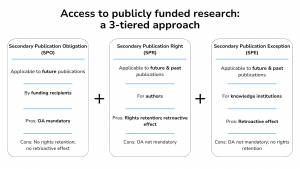
We recommend a three-tiered approach to open publicly funded research outputs to the public, immediately upon publication, where a secondary publication obligation co-exists with a secondary publication right. We consider that an obligation by the funding recipients to republish is a more consequential approach to protect the public interest, as it makes Open Access (OA) mandatory, ultimately ensuring that publicly funded research outputs are republished in OA repositories. A right is, however, necessary to ensure that the authors, and subsequently the funding recipients, retain the rights necessary to comply with the obligation. A right also provides a legal framework for the dissemination in OA repositories of publicly funded research outputs published before the entry into force of a secondary publication obligation.
In addition, we recommend the introduction of a copyright exception for the benefit of knowledge institutions, such as libraries and archives, to further support the task of making available research outputs published before the entry into force of secondary publication rights and obligations.
Resolving these issues would ideally be part of a more comprehensive regulation, a Digital Knowledge Act, which addresses the needs of research organisations and other knowledge institutions in the digital environment more broadly.
The post New policy paper on access to publicly funded research appeared first on COMMUNIA Association.













































































































![Reference manager - [Onderhoud aantekeningen]](https://www.labyrinth.rienkjonker.nl/sites/default/files/styles/medium/public/Reference%20manager%20v3%20-%20%5BOnderhoud%20aantekeningen%5D%2014-2-2010%20102617_0.jpg?itok=OJkkWhxY)
![Reference manager - [Onderhoud aantekeningen]](https://www.labyrinth.rienkjonker.nl/sites/default/files/styles/medium/public/Reference%20manager%20v3%20-%20%5BOnderhoud%20aantekeningen%5D%2014-2-2010%20102628.jpg?itok=CUvhRRr7)
![Reference manager - [Onderhoud bronnen] - Opnemen en onderhouden](https://www.labyrinth.rienkjonker.nl/sites/default/files/styles/medium/public/Reference%20manager%20v3%20-%20%5BOnderhoud%20bronnen%5D%2014-2-2010%20102418.jpg?itok=d7rnOhhK)
![Reference manager - [Onderhoud bronnen]](https://www.labyrinth.rienkjonker.nl/sites/default/files/styles/medium/public/Reference%20manager%20v3%20-%20%5BOnderhoud%20bronnen%5D%2014-2-2010%20102433.jpg?itok=CgS8R6cS)
![Reference manager - [Onderhoud bronnen]](https://www.labyrinth.rienkjonker.nl/sites/default/files/styles/medium/public/Reference%20manager%20v3%20-%20%5BOnderhoud%20bronnen%5D%2014-2-2010%20102445_0.jpg?itok=4oJ07yFZ)
![Reference manager - [Onderhoud bronnen]](https://www.labyrinth.rienkjonker.nl/sites/default/files/styles/medium/public/Reference%20manager%20v3%20-%20%5BOnderhoud%20bronnen%5D%2014-2-2010%20102500.jpg?itok=ExHJRjAO)
![Reference manager - [Onderhoud bronnen]](https://www.labyrinth.rienkjonker.nl/sites/default/files/styles/medium/public/Reference%20manager%20v3%20-%20%5BOnderhoud%20bronnen%5D%2014-2-2010%20102524.jpg?itok=IeHaYl_M)
![Reference manager - [Onderhoud bronnen]](https://www.labyrinth.rienkjonker.nl/sites/default/files/styles/medium/public/Reference%20manager%20v3%20-%20%5BOnderhoud%20bronnen%5D%2014-2-2010%20102534.jpg?itok=cdKP4u3I)
![Reference manager - [Onderhoud thema's en rubrieken]](https://www.labyrinth.rienkjonker.nl/sites/default/files/styles/medium/public/Reference%20manager%20v3%20-%20%5BOnderhoud%20themas%20en%20rubrieken%5D%2020-9-2009%20185626.jpg?itok=zM5uJ2Sf)













![Reference manager - [Raadplegen aantekeningen]](https://www.labyrinth.rienkjonker.nl/sites/default/files/styles/medium/public/Reference%20manager%20v3%20-%20%5BRaadplegen%20aantekeningen%5D%2020-9-2009%20185612.jpg?itok=RnX2qguF)
![Reference manager - [Relatie termen (thesaurus)]](https://www.labyrinth.rienkjonker.nl/sites/default/files/styles/medium/public/Reference%20manager%20v3%20-%20%5BRelatie%20termen%20%28thesaurus%29%5D%2014-2-2010%20102751.jpg?itok=SmxubGMD)
![Reference manager - [Thesaurus raadplegen]](https://www.labyrinth.rienkjonker.nl/sites/default/files/styles/medium/public/Reference%20manager%20v3%20-%20%5BThesaurus%20raadplegen%5D%2014-2-2010%20102732.jpg?itok=FWvNcckL)
![Reference manager - [Zoek thema en rubrieken]](https://www.labyrinth.rienkjonker.nl/sites/default/files/styles/medium/public/Reference%20manager%20v3%20-%20%5BZoek%20thema%20en%20rubrieken%5D%2020-9-2009%20185546.jpg?itok=6sUOZbvL)
![Reference manager - [Onderhoud rubrieken]](https://www.labyrinth.rienkjonker.nl/sites/default/files/styles/medium/public/Reference%20manager%20v3%2020-9-2009%20185634.jpg?itok=oZ8RFfVI)

![Reference manager - [Onderhoud aantekeningen]](https://www.labyrinth.rienkjonker.nl/sites/default/files/styles/medium/public/Reference%20manager%20v3%20-%20%5BOnderhoud%20aantekeningen%5D%2014-2-2010%20102603.jpg?itok=XMMJmuWz)


































































